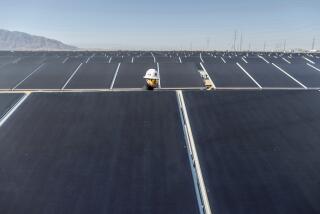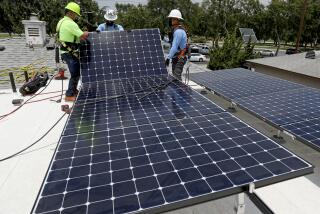The renewable energy future
Remember rain?
As Los Angeles creaks through its driest year on record and nervously awaits its next explosive wildfire, many wonder if global warming is already taking a toll. Nobody really knows; California has always had intermittent droughts, after all. But climate models predicted this situation. Changes in ocean temperatures and currents driven by things such as the melting of the Greenland ice shelf -- which is happening a lot faster than scientists expected -- will probably produce an even more desert-like climate in L.A.
FOR THE RECORD:
Energy sources: An editorial Monday on renewable energy said that costs for solar panels remain high because the world is running out of silicon. In fact, there is a shortage of polysilicon, a manufactured material of which silicon is the basic component. The editorial also said that a “100-square-mile” area of Nevada, if equipped with solar devices, could meet all of the United States’ power needs. It should have said a “100-mile-square” area. —
Efforts to slow or halt that process have to include a switch to cleaner energy. Coal-burning power plants account for more than 40% of the nation’s carbon dioxide emissions (the key culprit in global warming) while supplying half our electricity. California is already on the case. Last year, it passed a law that says 20% of the state’s electricity must come from renewable sources by 2010, and 33% by 2020. Even the sluggish federal government is considering a crackdown, with the House energy bill requiring that 15% of U.S. power come from renewable sources by 2020.
Renewable power is fueled by clean sources such as wind, sunshine, geothermal currents and ocean tides or waves. Though its potential is vast, serious technological and policy problems must be overcome before it will play much of a part in our energy mix. Here’s a look at the hopes and hurdles for the two renewable sources likely to have the biggest effect on California.
The answer is blowin’ in the windBeside the 580 Freeway east of the San Francisco Bay, the hills are alive with the sound of . . . whooshing. Wind turbines cover the hills for miles around, some like giant eggbeaters but most looking like big airplane propellers on poles, spinning in the near-constant breeze through Altamont Pass. When it was built starting in 1981, this was the largest wind farm in the world, and it cemented California’s place as a pioneer in alternative energy. Now it’s an outdated relic, relying on old-fashioned technology that produces less power and kills more birds than modern equipment.
Altamont Pass was intended to spark a wind-power revolution in California, but it fizzled, largely because of low natural-gas prices that made renewable energy sources noncompetitive. The state has other small wind farms in Tehachapi, Solano County and San Gorgonio Pass near Palm Springs, but they’re operating well below their potential. Although the state gets 11% of its electricity from all renewable sources -- among the best records in the country -- that percentage hasn’t risen in the last four years.
Meanwhile, Texas has leapfrogged past California in wind-power generation. Texas has a number of natural advantages, such as plenty of wide-open, windy spaces, as well as some policy advantages. Ironically, the state’s traditional hostility to environmental and other regulation is in this case a plus, making it easier to get government approval for wind farms. Elsewhere, they often run into flak from NIMBYs, bird lovers and environmentalists who worry about power lines cutting through environmentally sensitive areas to reach remote, windy spots. In California, proposed transmission lines from coming wind farms in Tehachapi are under fire, as are lines that would carry electricity from planned solar power plants in the Mojave Desert. To the east, wealthy homeowners in Cape Cod may succeed in blocking the Cape Wind offshore wind farm in the Nantucket Sound, a project that threatens to spoil their ocean views.
Wind turbines, especially the older devices in California, can be buzz saws for birds and bats, though newer, taller turbines seem less deadly. In any case, a study by the National Academy of Sciences found no evidence that wind farms are decreasing bird populations; global warming is a much bigger threat to birds and bats than wind blades. Renewable power is too important to allow such projects to be derailed by narrow interest groups, which is why California and other states should take steps to streamline the approval process.
The United States gets less than 1% of its power from wind, but the industry is growing at about 25% a year worldwide and, thanks mainly toTexas, the U.S. is building wind farms faster than any other country. The potential is almost limitless. A 2005 study by researchers at Stanford University found that there is enough wind worldwide to satisfy global electricity demand seven times over, even if only 20% of the power could be captured. Such theoretical figures, of course, don’t address the practicalities of cost, access and variability (the wind doesn’t blow all the time, so wind power has to be supplemented by other sources) that make harvesting so much wind power nearly impossible.
Besides community opposition, a key roadblock is the lack of transmission lines. Wind power has a classic chicken-and-egg problem: Investors don’t want to build wind farms unless lines already exist to connect them to urban centers, and utilities don’t want to add lines until the turbines are spinning. California, Texas and two other states have come up with a solution. In April, the Federal Energy Regulatory Commission signed off on a plan to shift part of the cost of power lines to California consumers. Utilities can charge higher rates to pay for building lines to high-wind areas; once generators connect to the lines, the cost will be recovered via access charges paid by the wind farms. This should become a national model.
The first to benefit from the new regulation will probably be a transmission project from Southern California Edison that is eventually expected to carry 4,500 megawatts from wind farms planned in Tehachapi -- that’s the equivalent of two nuclear power plants the size of San Onofre, or enough to power 2.9 million homes.
The sun also risesRep. Dennis Cardoza’s bad experience with solar power might make things a little better for the rest of us, further proof that all politics are personal.
Cardoza (D-Atwater) wanted to install solar panels on his home. He discovered that even in California, the center of the nation’s solar-power industry, that’s an expensive and impractical proposition. He ended up spending $80,000 on the system, including $2,500 on permits alone -- enough to render meaningless the $2,000 tax credit given by the federal government to encourage solar power. Cardoza responded by teaming up with Sen. Robert Menendez (D-N.J.) onbillsthat would put a $500 cap on permit and licensing fees for residential solar installation and require utilities to buy back excess solar power from home generators.
Such efforts are long overdue at the federal level. California, meanwhile, is making greater progress, though Cardoza’s experience shows that it still hasn’t gone far enough. Gov. Arnold Schwarzenegger’s Million Solar Roofs initiative helps subsidize solar panels and will eventually make solar homes an option in new housing developments. Last week, the Legislature passed a bill that will extend subsidies to solar water heating systems. Yet the subsidies still aren’t high enough to make solar a very attractive option for most homeowners or businesses.
By far the biggest hurdle to expansion of solar power is cost. Solar panels are usually made of silicon, and the world is running out of it. Yet the economics of solar may be about to change. Aided by hefty infusions of venture capital in recent years, solar companies are on the cusp of developing new technologies that generate more power using less silicon, prompting predictions that costs for solar systems could be cut in half within the next three years.
That process might be accelerated with a little more nurturing from the federal government. This year, the Energy Department will spend $303 million on research and development for nuclear power and $427 million on coal, while forking out a paltry $159 million on solar. That may be because the country gets less than 0.01% of its electricity from the sun, but it doesn’t reflect solar power’s potential.
Enough solar energy hits the Earth in an hour to supply all the world’s electricity needs for a year. A 100-square-mile area of Nevada, if equipped with solar devices, could supply the U.S. with all the power it needs, according to the Energy Department. Again, such pronouncements don’t address the real-world practicalities. But given that neither coal nor nuclear power is a practical solution to global warming, U.S. research priorities are badly skewed.
If roof-mounted solar panels aren’t quite ready for prime time, concentrated solar power systems might soon become a hit. These are usually arrays of reflectors installed in sunny areas like the Mojave Desert, where they concentrate sunlight to heat a liquid that turns to steam and powers a turbine. The Solar Energy Generating Systems, an installation of nine solar arrays in the Mojave that puts out 354 megawatts, has been considered the biggest such plant in the world, but it won’t be for long. Five more Mojave plants are scheduled to come on line in the next few years; together they will generate more than 1,000 megawatts. These projects have to jump many of the same transmission hurdles as wind farms.
The government can do many other small things to encourage renewable power, like raising subsidies and extending production tax credits, but they would have only an incremental effect. There is one genuine solution to climate change: Users of fossil fuels must pay the full cost of their environmental damage. A carbon tax would instantly create a thriving market for clean, alternative power sources such as wind and solar. The tax is almost an inevitability; the only question is, how much damage does global warming have to wreak before it becomes politically acceptable?
More to Read
Start your day right
Sign up for Essential California for news, features and recommendations from the L.A. Times and beyond in your inbox six days a week.
You may occasionally receive promotional content from the Los Angeles Times.






